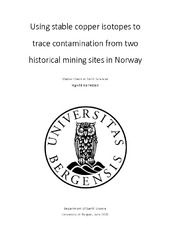| dc.description.abstract | During the last few decades, the stable copper isotope system (d65Cu) has gained attention because of its potential as a method to indicate the source of copper in contaminated surface waters. The d65Cu of dissolved copper is a result of the isotopic composition of source rocks as well as fractionation that may occur during weathering, biological processes, organic complexation and inorganic adsorption. The most significant copper isotope fractionation occurs from oxidative weathering of sulfides exposed to atmospheric O2 and water, which is the key process responsible for acid mine drainage and the release of heavy metals into the environment. This thesis tests the stable copper isotope system as a tracer for copper in contaminated surface water around two historical sulfide mines in Trøndelag, Norway. The two study areas are Storwartz mining field in Røros and the copper mines in Løkken Verk. The closed mines are still considered an environmental risk and are responsible for heavy metal release and acidity into local surface waters. We collected samples of surface waters and potential sources of copper (ores, background rocks, mining waste) and analyzed samples for major and trace element concentrations by ICP-OES, and copper isotope ratios (d65Cu) by multi-collector-ICP-MS. Sampled surface water show copper concentrations above 8 ppm and pH ranges from neutral to below pH 4. The contamination appears to be higher in Røros compared to Løkken, which indicates that the remediation measures at Løkken has successfully reduced the release of copper into the environment and also neutralized acid mine drainage to near-neutral pH. In Røros, the most contaminated samples show a relatively small range of d65Cu (avg. +1.35 ± 0.27‰, n=6). Less contaminated samples generally show higher d65Cu, besides two samples displaying background copper isotope signature. In all sampled surface water, d65Cu ranges from +0.10‰ to +6.89‰. The variation in surface water d65Cu is higher in Røros, and solid samples d65Cu are consistently lower. Copper isotope signatures of contaminated natural surface waters represents a complex biogeochemical system. Results show that most copper found in the surface waters are likely derived from weathering of exposed mine waste, and thus highlighting the method’s potential as an environmental tracer. | en_US |
